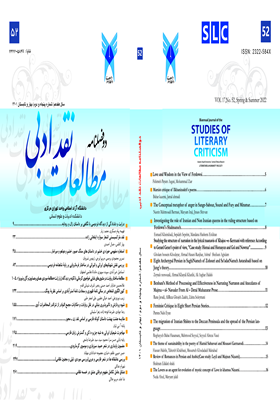Eight Archetypal Persian in SaghiNameh of Zohouri and Sa’adatNameh Astarabadi based on Jung's theory
Subject Areas : مطالعات نقد ادبی
زینب نوروزعلی
1
![]() ,
ahmad khatibi
2
*
,
aliasqar halabi
3
,
ahmad khatibi
2
*
,
aliasqar halabi
3
1 - Ph.D. student in Persian language and literature, Azad University, Central Tehran Branch
2 - Assistant Professor of Persian Language and Literature. Azad University Central Tehran Branch
3 - Assistant Professor, Department of Persian Language and Literature, Central Tehran Branch, Islamic Azad University, Tehran, Iran
Keywords: comparative literature, Conscious and Unconscious, Archetypal Ideas, Archetypal Persons,
Abstract :
Archetypal ideas include person, situation, and symbols. The idea of personality is very common in Astarabadi's Sa’adat Nameh and Zohouri’s Saghi Nameh. However, due to the unknown nature of these two works, not enough research has been done on them and many of their valuable angles have been hidden.Therefore, by examining this component in the above works, we intend to help interpret their verses and answer the questions that cognitive emergence and astronomy are related to the ideas of archetypes and what is the frequency of each idea in SaghiNameh and Sa’adatnameh. It seems that despite not knowing the knowledge of archeology in the modern sense, Zohouri and Astrabadi had a deep and accurate knowledge of the ideas of archaism. And they have used them in a special way by using the element of imagination in their works. Also in these two works, the ideas of religious and national figures were superior to other types and the idea of the seeker is only for the poet who has searched and finally reached mysticism.This research is presented in descriptive-analytical method As a result.

